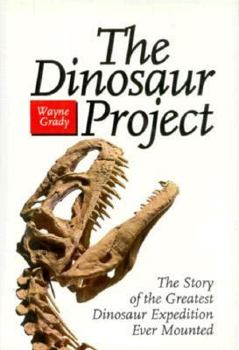The Dinosaur Project: The Story of the Greatest Dinosaur Expedition Ever Mounted
No Synopsis Available.
Format:Hardcover
Language:English
ISBN:0921912463
ISBN13:9780921912460
Release Date:June 1993
Publisher:MacFarlane Walter & Ross
Length:261 Pages
Weight:1.60 lbs.
Dimensions:1.1" x 7.0" x 10.1"
Customer Reviews
2 ratings
Crossing continents for fossils
Published by Thriftbooks.com User , 20 years ago
One of the little considered aspects of science is how it acts as a medium of diplomacy. Studying the wonders of nature, whether of the past or present, brings together people with common interests. In this book Grady relates the events taking place in the 1980s and '90s when Chinese and Canadian paleontologists undertook a major project to dispel some of the mysteries of dinosaur evolution. Well researched and superbly written, Grady here displays the writing skills that would propel him to become one of Canada's foremost science journalists. The Canada-China Dinosaur Project was considered by most of its participants as a resurrection of work begun many years ago. Roy Chapman Andrews, adventurer, researcher, promoter, went to China in the 1920s seeking evidence of human origins. Instead he stunned the world by finding dinosaur eggs. Interruptions of revolution, wars cold and hot and slim communications links prevented proper follow-up on Andrews finds. Phil Currie and Dale Russell, Canadian paleontologists, sought to identify links that might show relationships between Asian and North American dinosaurs. Grady traces their efforts, following the teams from Mongolian deserts to bleak Arctic islands. There are personality clashes, disputes over resources and inadequate equipment. In the end, the broader needs of good science overcame the petty hindrances and the Project proved an astounding success. Grady reviews the search for fossils in the Canadian west in opening the tale. In the late 19th Century, the Alberta Badlands were a magnet for fossil hunters. In some places you might trip over fossils recently revealed by soil erosion. Ultimately, the finds led to preserves and the now-famous Royal Tyrrell Museum of Paleontology outside Drumheller. Currie took up the idea of the joint-nation project in the spirit of Carl Sagan's Russian-American Soyuz space project. Currie called it "dinosaurs for peace." A decade of cooperative research, according to Grady, paid enormous dividends for science. The evidence proved another verification that Asia and the Americas were joined in the ancient past.Grady's fine writing is further graced by numerous photographs and maps. In reminding us that the geography [and geology] of Canada and China are similar, he reinforces that view with excellent photographs. There are maps of the areas with exploratory routes indicated. The scale, necessarily small, cannot fully convey the distances travelled in search of fossils. Added to these illustrations are excellent diagrams of the dinosaurs in skeleton and body plan. In all this book is a trove of information, feeling and discovery. [stephen a. haines - Ottawa, Canada]
Grady's narrative style brings the reader along
Published by Thriftbooks.com User , 24 years ago
The book The Dinosaur Project, by Wayne Grady, describes the joint Canadian and Chinese paleontological project starting in 1985. During the course of this project, Canadian researchers worked alongside Chinese researchers in the paleontological cornucopia of the Gobi Desert, as well as Chinese workers working with Canadians in the also fruitful Southern Alberta Badlands and the Canadian High Arctic. The field areas are so harsh and the characters are so interesting that this book could easily be made into a Spielberg movie. The start of the book immediately draws in the reader by describing the history behind the project. This project is referred to as the largest and most ambitious modern dinosaur hunting expedition ever mounted. It detailed the networking of the Chinese and Canadian colleagues over several years at various conferences until the project eventually became a reality. Narrative style keeps the reader interested as the paleontogists go into extreme conditions in the field, and as their finds are put into perspective relative to contemporary paleontogical dogma. This book was surprisingly gripping for a bone book. It covered many important paleontological theories, but kept the jargon to a minimum. Quotations and anecdotes were often used to relay how science works as well; science both as an abstract methodology and also the reality of working in extreme conditions. One quotation in particularly was well-worded "science is a way of thinking; it's how we move from what we think we don't know to what we think we know" (Dale Russel). The anecdotal style of the book is what really makes it well-written.




